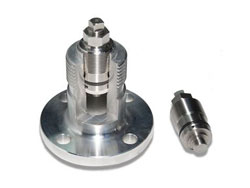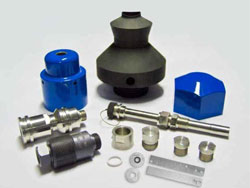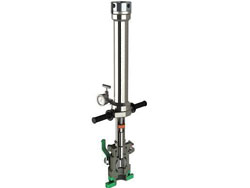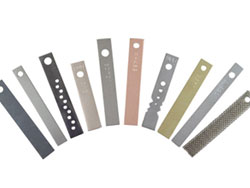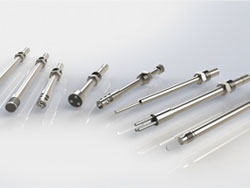Services
Solutions
Access Fitting Corrosion Coupons
In pressurized process systems, access fittings are intended to provide corrosion and erosion monitoring. <br> With specialized tools, the monitoring device can be safely placed and withdrawn without the need for expensive shutdowns or brief isolations.<br> There are two connection types for the Access Fitting Body: raised face flange and flare weld. <br>It is possible to insert and remove several kinds of corrosion coupons, corrosion probes, and erosion probes using the access fitting.
Retractable Coupon Holder
specifically made to detect corrosion coupons in systems under pressure. <br>There is no need for expensive shutdowns or transient isolations when the coupon may be inserted and removed via a permanent isolation valve. <br>The holder comes with reduced rod diameters of 5/8", 3/8", and 3/8" with order lengths of 18", 24", 30", 36", 42", and 48".
Retriever
Allow the entire spectrum of retrievable monitoring probes, coupon holders, and chemical injection to be removed safely and easily when the pipeline or vessel is running under pressure.
Service valves
used to attach the retriever tool to the Access Fitting that has to be serviced; its main purpose is to hold the line pressure in check while the injection device or monitoring probe is being replaced or taken out. <br>The NACE MR-0175 (92 Rev) standards for materials acceptable for use are met by all service valves.<br> There are service valves rated for 400 bar (5700 psi) and 250 bar (3600 psi). <br>Furthermore, service valves with a 250 bar rating weigh only 23 kg altogether, making them incredibly small.
Internal Corrosion Monitoring Systems
Corrosion monitoring is the practice of measuring the corrosivity of oil and gas pipelines using “probes” which are inserted into pipelines, and which are continuously exposed to the flow condition. The amount of corrosion will vary, depending on factors such as temperature, total pressure, CO2 and H2S content of the gas, pH of the water, flow conditions, use of inhibiting chemicals and more
Internal Corrosion Monitoring Systems Products
1- Coupons
The corrosion coupon is one of the most useful tools for monitoring corrosion. Coupons are of a predetermined shape, size and surface area, and are typically made of a metal of similar chemical composition to that of the process equipment. Their weight and surface preparation is recorded before insertion into the process stream, and they are then re-weighed and visually analyzed after a set exposure period. Lab analysis provides the corrosion rate (mpy), observations (before and after cleaning) and measurements regarding visual damage (such as pitting and scaling).
Corrosion coupons have many advantages. Coupons provide accurate results at a reasonable cost. They are simple to use and are able to provide general information that is both quantitative and visual on several types of corrosion, without relying on theoretical approximations. Coupons are also extremely versatile, as they can be used in any type of corrosive environment.
2- Probes
There are various designs of probes that use proven scientific methods to measure corrosion. The most common types of probes are electronic. Linear Polarization Resistance and Electrical Resistance are two examples of widely used electronic probes. Other probes, such as hydrogen probes, measure hydrogen transmission or diffusion that can lead to mechanical damage, while sand probes measure erosion.
Almost all probes have electrical connections that allow them to connect to electronic instruments or remote monitoring systems.
The advantage of probes is that they typically provide faster response than corrosion coupons, allowing better identification of the moment that the corrosion rate changed. They also provide quantitative data on the rate of corrosion, which can be translated into impacts, such as wall thickness loss per annum.
3- Access fitting systems
An access fitting system provides access to pipework for the insertion or removal of probes, impressed current anodes, corrosion coupons and more. For example, a corrosion access fitting enables users to attach or insert anodes for corrosion control products without the need to shut down the entire line.
4- Retrievers & Service Valve
- 3,600 psi.
- 6,000 psi.
5- Solid Plug & Hollow Plug
The solid plug & Hollow Plug: Solid Plug Assemblies are the internal elements of the access fittings which act as the seal of access fitting to keep the road strain in addition to the retrievable provider for holding the monitoring devices. Hollow plugs – used for ER probes, LPR probes, Galvanic probes, Sand probes, Hydrogen probes and any other type of sensors that require a cable connection.
Internal Corrosion Monitoring Systems Features
Simply
Monitoring corrosion is the process of following a material's slow degradation over time.
Safety
Corrosion monitoring is critical for any industry that relies on assets that degrade over time.
Cost reduction
If an item fails early due to rust, it can be extremely costly to replace.
Improved Efficiency
Corrosion monitoring can increase the efficiency of industrial operations in addition to lowering expenses.

